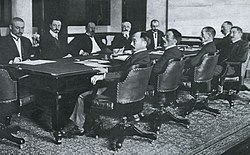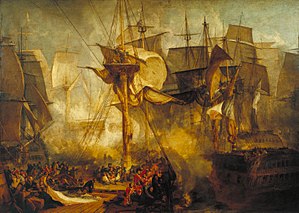Wednesday, October 28, 2009
Sarojini Naidu
Habeas Corpus Act 1679
Magna Carta
Magna Carta, also called Magna Carta Libertatum (the Great Charter of Freedoms), is an English legal charter, originally issued in the year 1215. It was written in Latinand is known by its Latin name. The usual English translation of Magna Carta is Great Charter.
Magna Carta required King John of England to proclaim certain rights (pertaining to freemen), respect certain legal procedures, and accept that his will could be bound by the law. It explicitly protected certain rights of the King's subjects, whether free or fettered — and implicitly supported what became the writ of habeas corpus, allowing appeal against unlawful imprisonment.
Marxism
Marxism is the political philosophy and economic worldview based upon a materialist interpretation of history, a Marxist analysis of capitalism, a theory of social change, and anatheist view of human liberation derived from the work of Karl Marx and Friedrich Engels; three primary aspects of Marxism are:
- The dialectical and materialist concept of history — Humankind's history is fundamentally that of the struggle between social classes. The productive capacity of society is the foundation of society, and as this capacity increases over time the social relations of production, class relations, evolve through this struggle of the classes and pass through definite stages (primitive communism, slavery, feudalism, capitalism). The legal, political, ideological and other aspects (ex. art) of society are derived from these production relations as is the consciousness of the individuals of which the society is composed.
- The critique of capitalism — In capitalist society, an economic minority (the bourgeoisie) dominate and exploit the working class (proletariat) majority. Marx uncovered the interworkings of capitalist exploitation, the specific way in which unpaid labor (surplus value)is extracted from the working class labor theory of value, extending and critiquing the work of earlier political economists value. Although the production process is socialized, ownership remains in the hand of the bourgeosie. This forms the fundamental contradiction of capitalist society. Without the elimination of the fetter of the private ownership of the means of production, human society is unable to achieve further development.
- Advocacy of proletarian revolution — In order to overcome the fetters of private property the working class must seize political power internationally through a social revolution and expropriate the capitalist classes around the world and place the productive capacities of society into collective ownership. Upon this material foundation classes would be abolished and the material basis for all forms of inequality between humankind would dissolve.
Glorious Revolution
From Wikipedia, the free encyclopedia
The Glorious Revolution, also called the Revolution of 1688, was the overthrow of King James II of England (VII of Scotland and II of Ireland) in 1688 by a union ofParliamentarians with an invading army led by the Dutch stadtholder William III of Orange-Nassau (William of Orange) who, as a result, ascended the English throne as William III of England. The expression "Glorious Revolution" was first used by John Hampden in late 1689,[1] and is an expression that is still used by the Westminster Parliament.[2]
The Glorious Revolution is also occasionally termed the Bloodless Revolution, albeit inaccurately. In England there were two significant clashes between the two armies, and anti-Catholic riots in several towns.[3] There was also the Williamite War in Ireland and serious fighting in Scotland (notably the Battles of Killicrankie and the Dunkeld).[4] The revolution also led to the collapse of the Dominion of New England and the overthrow of Maryland's government.
Treaty of Portsmouth
From Wikipedia, the free encyclopedia

The Treaty of Portsmouth formally ended the 1904-1905 Russo-Japanese War. It was signed on 5 September 1905[1] after negotiations at the Portsmouth Naval Shipyard near Portsmouth, New Hampshire in the United States.
Foreign History Watch
Battle of Trafalgar
From Wikipedia, the free encyclopedia
| ||||||||||||||||||||||||||||||
| ||||||||||||||||||||||||||||||
| ||||||||||||||||||||||||||||||
The Battle of Trafalgar (21 October 1805) was a sea battle fought between the British Royal Navy and the combined fleets of the French Navy and Spanish Navy, during the War of the Third Coalition (August–December 1805) of the Napoleonic Wars (1803–1815). The battle was the most decisive British naval victory of the war. Twenty-seven British ships of the line led by Admiral Lord Nelson aboard HMS Victory defeated thirty-three French and Spanish ships of the line under French Admiral Pierre Villeneuve off the south-west coast of Spain, just west of Cape Trafalgar. The Franco-Spanish fleet lost twenty-two ships, without a single British vessel being lost.
The British victory spectacularly confirmed the naval supremacy that Britain had established during the past century and was achieved in part through Nelson's departure from the prevailing naval tactical orthodoxy, which involved engaging an enemy fleet in a single line of battle parallel to the enemy to facilitate signalling in battle and disengagement, and to maximize fields of fire and target areas. Nelson instead divided his smaller force into two columns directed perpendicularly against the larger enemy fleet, with decisive results.
Nelson was mortally wounded during the battle, becoming Britain's greatest war hero. The commander of the joint French and Spanish forces, AdmiralPierre de Villeneuve, was captured along with his ship Bucentaure. Spanish Admiral Federico Gravina escaped with the remnant of the fleet, and succumbed months later to wounds he sustained during the battle.
Wednesday, October 14, 2009
FACTS OF MAHATMA GANDHI!!!!!!!!
Here is a brief summary of some of the major facts associated with Mahatma Gandhi. These facts highlight some of the major achievements of Mohandas Gandhi and provide valuable information on Mahatama Gandhi.
Birth: October 2, 1869
Death: January 30, 1948
Place of Birth: Porbandar, Gujarat
Father: Karamchand Gandhi
Mother: Putlibai
Wife: Katurbai
1888-1891: Studied law in London
1893: Sailed for South Africa
1906: Began Satyagraha campaign in South Africa to protest the requirement that Indians be fingerprinted and carry identification cards
1915: Returned to India from South Africa
1917: Initiated Champaran Satyagraha to alleviate the condition of indigo planters
1919: Instituted Satyagraha campaign in India to protest the Rowlatt Acts, which deprived all Indians of important civil liberties.
1922: Ended Non-Cooperation movement against British Raj after his followers were involved in a series of riots and disturbances that violated his policy of nonviolence
1930: Led Dandi March to collect salt in protest of the British salt tax.
1931: Signed a pact with Lord Irwin to suspend the Civil Disobedience Movement and went to London to attend Round Table Conference.
1932: Fasted to protest the treatment of people who belonged to no Hindu caste, the Harijans or Untouchables
1942: Launched Quit India Movement against British Raj.
January 30, 1948: Assassinated by Nathuram Godse, a Hindu extremist
Source--http://gleez.com/articles/information/facts-of-mahatma-gandhi



